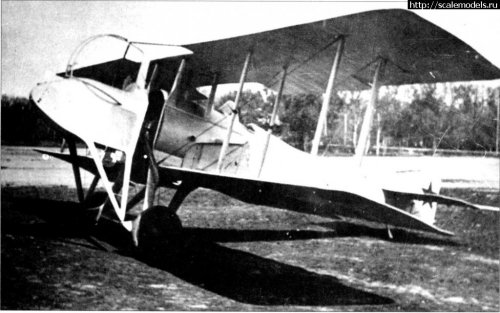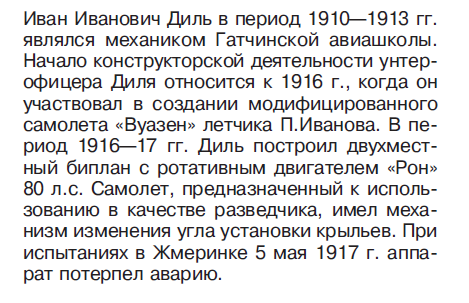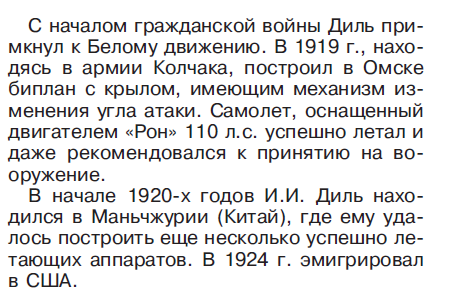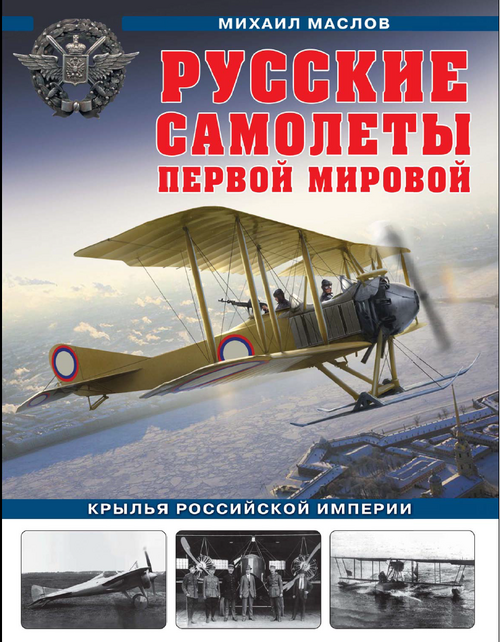Ivan Ivanovich Dil' (Иван Иванович Диль) has always been an enigmatic designer. There is only a very scarce biographical information on him.
From the following sources I tried to compile an overview of the aircraft designed by Dil':
- Шавров - История конструкций самолетов в СССР до 1938г., 1986, p. 208, 220
- Маслов - Русские самолеты 1914-1917, 2006, p. 87
- Кондратьев, Хайрулин - Авиация гражданской войны,1994, p. 35
- Хайрулин, Кондратьев - Военлеты погибшей империи. Авиация в Гражданской войне, 2008, p. 128
- Нешкин, Шабанов - Авиаторы - кавалеры ордена Св. Георгия и Георгиевского оружия периода Первой мировой войны 1914-1918 годов, 2006, p. 20
- Соболев - Наши соотечественники в зарубежном авиастроении, 1996, pp. 31-34
- Демин - Авиация Великого соседа. Книга 1. У истоков китайской авиации, 2008, pp. 31-32
- Andersson - A History of Chinese Aviation, 2008, p. 63, 263
Since 1910 Dil' worked as an aircraft mechanic at the flying school of Gatchina. At the outbreak of WWI he became an aircraft mechanic and non-commissioned officer at the 6th Aviapark (South-Western Front).
In 1916 he participated in the design and construction of the VI (ВИ), the Voisin LAS modification by P. Ivanov, later series built by Anatra.
His first own design appeared in 1917, a two seat biplane with variable incidence of the wings, a common characteristic of all the Dil' planes.
After the revolution he took side with the Whites, and in 1919 built a second plane for the army of admiral Kolchak.
After the defeat of the Kolchak regime, he ended in the vast White Russian colony in Harbin, Manchuria. In Manchuria he built some other airplanes, before he apparently left for the USA. But nothing more is known of Dil' afterwards (according to Sobolev in the USA he took the name John Dil).
Aircraft designed by I.I. Dil'
1917 Biplane with 1 x 80 hp, Rhône. Two seater. Built in Zhmerinka (Жмеринка) at the Aviapark. It crashed on its first flight on 18 May 1917.
1919 Biplane with 1 x 110 hp, Rhône. Two seater. Built in Omsk at the Central Aviation Workshops of admiral Kolchak's army (TsAM - ЦАМ, Центральные авиационные мастерские). First flight: 18 August 1919 with lt. Rozhdestvensky (Рождественский). Good results, and 10 were ordered from TsAM in September 1919. None built.
In January 1920, after the defeat of the Kolchak regime, Dil' went with his second aircraft in service with the regime of ataman Semyonov in Chita. The same year he took refuge, still with his second plane, in the vast White Russian colony in Harbin, Manchuria.
On 22 September 1920 the well-known pilot A.Ya. Abakumenko (А.Я. Абакуменко) crashed to his death at the hippodrome of Harbin while flying the Dil' biplane.
It seems that this crashed plane was rebuilt, and after the reconstruction made his first flight on 8 June 1922, and a second flight on 18 June 1922. Pilot was D.A. Kudlayenko (Д.А. Кудлаенко - and not Kudaienko, as says Andersson).
British and American witnesses described the performances as exceptional, despite the old engine.
The Manchurian warlord Zhang Zuolin (Chang Tso-lin) began negotiations to buy the biplane (and other former White Russian armaments). In October 1922 it went in service with the Manchurian military, together with a number of White Russian pilots and mechanics.
1923 Biplane with 1 x 130 hp. Clerget. Two seater built in Harbin for the army of Zhang Zuolin. In service in July 1923.
1923 Biplane with 1 x 300 hp Salmson. Two seater for the army of Zhang Zuolin. Two built in Harbin. In service in July 1923.





